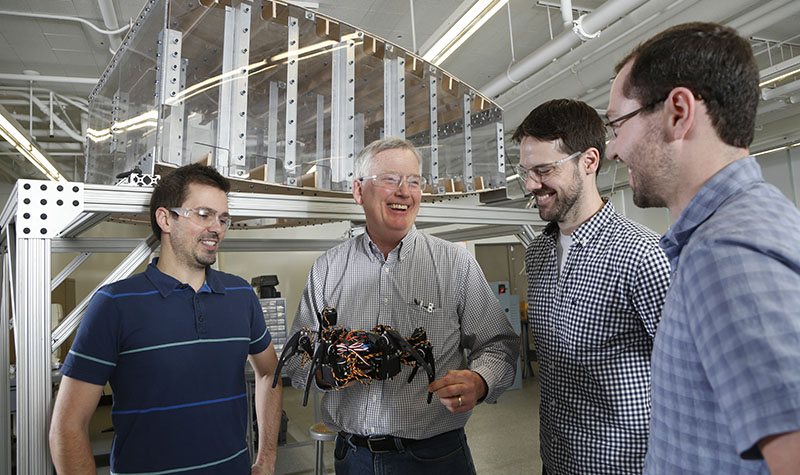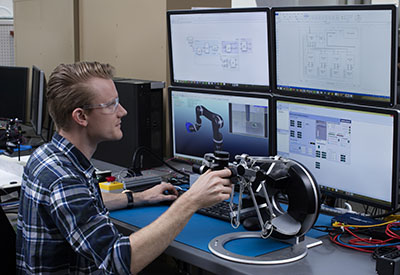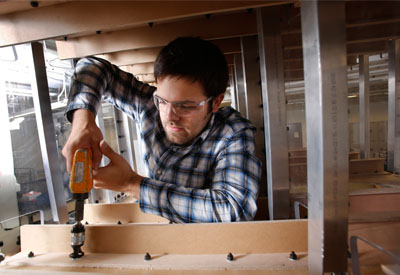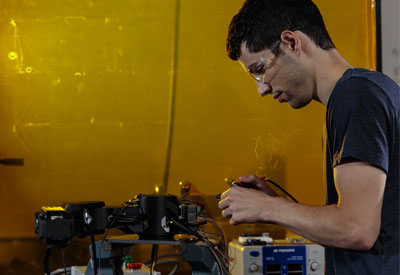By Chelsea Yates
July 5, 2016
The brainchild of an ME alumnus-turned-Boeing engineer and two faculty members, BARC presents a unique path for university-industry collaboration.

Jim Buttrick (center) with students in the BARC lab.
In most engineering labs on university campuses across the country, it’s not every day that students get to work alongside leading industry engineers.
Unless you’re an engineering student in the Boeing Advanced Research Center, or BARC, as it’s known at the UW.

ME PhD candidate and BARC research assistant Parker Owan tests a robotic system remote control in a virtual environment.
Opened in January 2015 and housed in the mechanical engineering (ME) building, the 4,300 square-foot facility pairs full-time Boeing engineers with students and professors to come up with solutions for Boeing projects. Though The Boeing Company and the UW have a long history of collaboration, this is the first time the two have worked together in a shared facility on campus.
An agreement between Boeing and the UW College of Engineering, BARC is the brainchild of Jim Buttrick, ’84 MS, a Boeing engineer and the center’s associate director, and ME professors Per Reinhall and Joseph Garbini. After many years of working in industry, Buttrick saw a good opportunity for students to gain practical, hands-on experience and Boeing to benefit more directly from researchers.
“The student experience within BARC provides outstanding preparation for real-world, hands-on jobs,” Buttrick explains. “Rather than send students off-campus, it allows industry to come to the students. It’s an innovative approach to higher education and industry partnership.”
This arrangement speeds up the process for students to transition from an academic to an industrial work environment. Currently more than 7,400 UW alumni are employed by The Boeing Company in Washington State, and of that number, nearly 1,200 hold mechanical engineering degrees.
An innovative model
“The establishment of BARC represents a new paradigm in industrial research at the UW,” says Reinhall, who also serves as one of the center’s co-directors.
When BARC opened, eight full-time Boeing engineers moved to the UW lab space as affiliate instructors. Eight graduate students and six faculty joined the group. Since then, the team has grown to include two undergraduates and three additional Boeing engineers who are also working on advanced degrees at the UW.
So far, priority projects have focused on automation, robotics and aircraft assembly. “Overall, we’re interested in long-term improvements in the way we build airplanes. To start, we strategically chose projects where we want to solve a problem, but we see there are areas where we can employ academic talent to work portions of a project and come up with viable solutions,” Buttrick says.

Benjamin Janicki, a BARC research assistant, demonstrates the manual assembly process in a confined space.
One of the lab’s key projects is designed to make it easier for mechanics to access, build and repair the insides of airplane wings—shallow, narrow spaces where it is physically difficult to work. Other projects include automating the riveting of fuselages and predicting the final shape and size of certain aircraft structures.
Down the road, BARC plans to expand projects across the College into areas such as aeronautics and astronautics, chemical engineering, materials science, electrical engineering and computer science and engineering.
For first-year ME Ph.D. student Rose Hendrix, who researches industrial applications in augmented reality, BARC has provided an invaluable opportunity. “Boeing employees bring a high level of expertise, and it’s been great to tap into their knowledge daily,” she says. “We’ve also had the opportunity to tour Boeing facilities and meet people who we likely wouldn’t have had access to were it not for BARC.”
While students receive a more practical, hands-on experience, Boeing engineers gain access to fresh ideas and new research. Plus, Buttrick says, the students’ enthusiasm for real-world problem-solving can be very inspiring.
Of course, it’s not easy. One of the biggest challenges has been negotiating the different motivating factors that drive industrial and academic research. Prior to the center’s launch, Boeing, UW and College of Engineering leadership created a research master agreement to govern BARC. Yet since the center is not modelled after traditional grants-funded labs, its team must constantly evaluate structure and workflow.
BARC team members must meet project deadlines set by Boeing. “I’ve been asked if this puts unnecessary stress on students,” says Buttrick. “But I think learning how to react and adapt to industry-driven deadlines is one of the most important lessons we can teach students to prepare them for the working world they’ll enter after graduating.”
Real-world impact
Buttrick remembers that when he enrolled at the UW in the early 1980s, he couldn’t wait to begin tackling real world problems in his engineering classes. He soon discovered that he would have to wait until completing his degree and landing a job to get that experience.
Thanks to centers like BARC, this is not the case for students today.

Research assistant Alexis Ehrlich assembles a BARC-built robotic manipulator controller.
“Being at BARC allows me to actively work on things that people will directly benefit from,” says Hendrix. “We’re coming up with applications that address real-world problems and drive specific solutions, and that’s really exciting.”
As it continues to grow, BARC will have a direct impact on the way aircrafts are designed and assembled. The innovations being developed in collaboration between UW students and faculty and Boeing engineers will have a positive impact on occupational safety and quality of work environment for airplane workers.
“We get to have some of the most significant airplane manufacturing and design issues come through this lab,” Reinhall says. “It supports an exciting new trend in education where students learn by doing, along with close interaction with industry.”
BARC’s reach has extended into the College’s curriculum as well. This winter, the ME department offered Structural Engineering in Commercial Aircraft, a course for upper-level undergraduates and graduate students. Co-taught by UW faculty and Boeing engineers, the course provided an overview of major structural components, product development and certification, damage tolerance and factory/fleet support.
This convergence of academic and translational research exemplifies the ME department’s culture of innovation and commercialization. “We seek to meet industry needs by not only providing trained and skilled graduates for the workforce but by translating the expertise of our faculty into impact,” explains Reinhall.
For Buttrick, the center also represents something more personal.
“BARC has been an incredible way for me to give back to the UW,” he says. “Joe Garbini and Per Reinhall were both young professors when I was a student here, and it’s been great to come full circle and work with them to make BARC a reality for students and faculty.”
Find out more at barc.uw.edu.